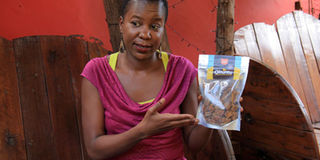Ex minister’s daughter makes tasty snacks from pumpkins

Natongo shows her packaged Obuntu snacks made from a combination of pumpkins and bogoya. Photo by Rachel Mabala
What you need to know:
- When Catherine Nantongo, daughter of former Minister of Agriculture Victoria Sekitoleko, was thinking of making a feasible product, she turned to the pumpkin.
- She makes her recipe at home but outsources other services like solar drying and packaging. Joan Salmon chronicles her efforts of making healthy meals out of this crawling plant.
Catherine Nantongo Sekitoleko was always craving of supplying health foods to her clients.
Having worked and lived in Beijing, China for 10 years, she wanted to put her ideas to work.
She had a hand at Papali Uganda Ltd, a cottage factory that began in her kitchen before she moved the production line to the more spacious garage.
She run Papali on the roof, a restaurant offering healthy food until she was intrigued in January 2015 by a customer. On a doctor’s recommendation he ordered for something free of processed sugars, wheat, preservatives and diary yet still sweet. This marked the beginning of her journey.
“I came up with a tentative product that I packed for my aunt to get feedback,” Nantongo shares.
But the ‘bread’ was already crumbs on delivery. Her aunt didn’t disappoint and instead put the crumbs into her millet porridge. The findings were marvellous as she liked the taste, giving Nantongo the go-ahead.
Bread into cereal
Marked by energy and enterprise, Nantongo crushed all the remaining bread at home into a cereal.
“Not everyone eats porridge. So, I was forced to create something that one could either eat as a snack or mix with other drinks,” the self-taught economics expert, said.
For the next few years, they worked on perfecting the recipe and also ensuring that it could be produced commercially.
The final recipe was finally crafted in December 2017. She made a few products for a laboratory test in April 2017 to measure the nutrition content.
Owing to its ingredients: bogoya (Gros Michel), pumpkin, coconut and spices, it was found to be nutritious.
However, Nantongo and her team felt the need to add proteins to make their prototype attractive for people that eat less fruits and vegetables. The vibrant young entrepreneur is also trying out several products.
What’s in a name?
By 2015, they were getting several orders for the snack although most customers were family and friends.
“These also acted as our critics. They were indeed tough but they helped us make necessary changes before we made it available to the public,” she says.
“When we finally started accepting orders from the public, we realised how much work went into transforming a product from the kitchen to the market,” Nantongo reminisces.
Trying to find a unique name, she chose Obuntu, closing the doors to Papali on the Roof restaurant March 2017.
Nantongo’s dad contributed to this name because while they had formerly called the product ‘Muesli’, he would barely pronounce it. He ended saying, ‘mpaayo obuntu buli’ loosely translated into ‘get me those things.’ That’s how the name was crafted.
But she prefers her version of trying to create oneness because the community sense of living in Buganda refers to ‘Obuntu’.
Market
By the end of 2018, Nantongo hopes that Obuntu will be available on the market countrywide.
Since hers is a premium product targeting health-conscious people seeking a tasty, healthy yet convenient snack, they are targeting upscale shops.
“The first place is our own shop in Ntinda, off Stretcher Road,” she shares.
They are also targeting well established cafes, health food restaurants, specialty shops and supermarkets, hotels and tourist lodges as well as airport shops.
Ingredients
The major ingredient is pumpkins which she obtains from Henry Kasozi of Nkokonjeru Farmers’ Association whom she learned about through Uganda Agri-Business Alliance.
Bogoya is got from her farm in Bweyogerere, Wakiso District which is supplemented for a Nakawa market trader, whom she has known since childhood. She gets spices from Nakasero market.
Costs
With her five employees, Nantongo produces one flavour. She hopes to make multiple flavours with natural flavourings and tropical fruits like mangoes, cocoa and flavours like local vanilla.
They process 15 kilos which cost an estimated Shs580,000 in ingredients.
Challenges
She is improving her product through trial and error, which she says, is sometimes frustrating and costly.
“I am still learning but one experience comes to mind. One time, I made a loss of Shs15m due to an error in spice measurement,” she reminisces.
Nantongo wears many hats. She is the accountant, nutritionist and the human resource specialist. Besides, she has to pay attention to detail and be creative.
“Access to finances and product promotion have been really challenging,” she says.
Partners along the way
Nantongo has partnered with Jakana Foods to access their mechanised driers as well as air-tight packaging facilities.
“They come in handy when we have bulk processing and it has helped us greatly with fluctuating power issues,” she says.
Why Pumpkins Are Fruit
Pumpkins are squash, and also gourds, but are they fruit? According to the Farmer’s Almanac, they are. And if we look at Merriam Webster’s definition of “fruit,” we can see why. A fruit is, “the usually edible reproductive body of a seed plant.” Pumpkins are edible, and if you’ve ever cut one open, you know it’s full of seeds, so the pumpkin is the fruit of the pumpkin vine.




